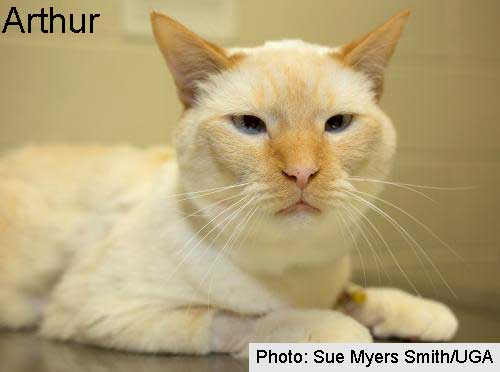This is hopeful news for cat guardians; a promising new diagnostic test which may pick up the early signs of kidney disease in cats.

Since chronic kidney disease is one of the leading causes of feline deaths, the importance of having a method available which can catch the signs in its earliest stages cannot be over- emphasized. Currently, when the symptoms are noticeable the disease is well advanced.
When a commercially viable test of this magnitude is accessible to veterinarians, it may help to prolong cats lives by months or perhaps even years. Through the use of proactive measures such as regular veterinary monitoring and further testing, along with feeding an appropriate diet to cats with this condition feeding, these measures can more effectively slow down the progress of kidney disease.
Unfortunately, however, at this time the only diagnostic test for feline kidney disease is a blood test measuring creatinine levels. Creatinine is a chemical that is created by the breakdown of muscle tissue, making it difficult for the kidneys to clear when they have become impaired. What is problematic with the existing test is that creatinine levels generally do not become abnormal until at least 70 percent of the kidney’s ability to filter waste from the blood has been lost.
But there is some promising news on the horizon for cat guardians and their kitties. A new biomarker called “SDMA” has been developed by researchers from Oregon State University, joined up with IDEXX Laboratories, and Hill’s Pet Nutrition. This biomarker could potentially become the basis of a new diagnostic test which can catch the early stages of kidney disease in cats.
What makes this finding so remarkable is that, in their research, scientists were able to demonstrate that this biomarker was able to identify kidney disease 17 years before the already available standard testing and, incredibly according to the university’s press release in one particular case, four years ahead of time.
Once a cat is diagnosed with kidney disease, it can be managed with a low protein1 and low phosphorous diet in addition to adding special antioxidants, L-carnitine, certain triglycerides and an Omega3 supplement. A professor at Oregon State’s College of Veterinary Medicine, Dr. Jean Hall said,
“Damage from [kidney disease] is irreversible, but this is an important advance, in that we should be able to identify the problem earlier and use special diets to slow the disease.”
The study of 32 healthy cats unearthed the SDMA biomarker and was published in the Veterinary Journal. This discovery may also be of benefit to canines as they age since they are also at risk of contracting kidney disease. According to the university, the scientists intend continue on with their research into this new biomarker in order to gain more information and learn more about its full potential in the field of early kidney disease detection.
Alternatively, according to Lyn Thomson, Bachelor of Veterinary Science (BVSc), DipHom, too little protein in the diet can lead to excessive weight loss that can be extremely detrimental to a cat’s general health (external link). Cats find low protein diets less palatable and often moving a cat to a raw, high quality protein diet from a renal prescription diet leads to improved appetite.
“Restricting the phosphate content of the diet appears to be quite beneficial in protecting the kidneys from further damage in cats with chronic renal failure. Phosphate can be restricted by removing high phosphate foods from the diet and using a phosphate binder if the blood phosphate concentrations are high despite being on a lowered phosphate diet.”
This writer is both extremely heartened and excited about this promising news concerning the potential of an earlier and more accurate method of detecting feline kidney disease. What do you think? Tell us your opinion in a comment.
Note:
- There is a rather extensive controversy among veterinarians in the treatment of feline kidney disease. While many veterinarians continue to prescribe low protein diets as the “gold standard”, others are very concerned about the muscle atrophy in cats resulting from low protein diets.

I am so very saddened to hear of all your losses to this vicious disease. I, too, have lost a few kitties to renal disease. This test will be wonderful if it works. That being said, I agree that by the time the BUN and/or creatinine levels are above normal, there is already sufficient loss of renal function. However, my vet has stated that the reason for doing senior bloodwork and urinalysis at least twice a year is so she can find evidence of renal disease BEFORE the values go above “normal”. She says that monitoring urine specific gravity is very important and once it starts to creep lower, she will begin treating for renal disease. As well, she begins treating cats for renal insufficiency/disease once the creatinine levels reach 1.5 even though that is still considered “normal”. She has been to lectures where the “experts” have stated that once the creatinine reaches 1.5, the kidneys are beginning to fail. I wish the laboratories would catch up with what the “experts” are saying……